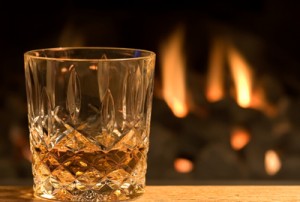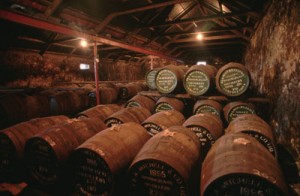
A Dram of Whiskey
Whiskey has never been hotter yet the basics are wildly misunderstood. The dedicated Whiskey drinker is well-versed on the basics and looks to examine the nuances of styles, distillers, and brands. When I talk with casual Spirits drinkers I am often reminded that outside my Whiskey geek bubble many people are still a little confused about the subject. Often I hear – “I don’t like Whiskey but I do like Bourbon,” not realizing that Bourbon is a Whiskey.
In an effort to recruit more would-be Whiskey fanatics I offer the following Whiskey primer.
What is Whiskey?
Whiskey is a very broad category of spirits produced throughout the world. Its origins are found in either Ireland or Scotland dependent upon which legend is most appealing to you. Whiskey in simple terms is a spirit – alcohol beverage – made from distilling a fermented mash of grains, or a single grain, and then aged in wood casks.
What’s with the ‘E’
In short, Scottish Whisky has no ‘e’ while Irish Whiskey does. There are many theories to explain this subtle difference including the cheeky suggestion that the Scots were too frugal to buy the additional vowel! The most credible explanation is that in the mid 1800s Scotch Whisky brands saturated the marketplace with loads of cheaply made Whiskey. Producers in Ireland, in an effort to further distinguish their products, adopted the use of the extra vowel. Certainly, this is not a condition that exists today but the subtle spelling variation endures. In the world of Whiskey we generally find that Canada, Japan, and Wales follow the Scottish spelling while the US uses both spellings. In no way should consumers believe that the choice of one spelling over the other is any indication of style.
The World of Whiskey
Scotch Whisky
Scotch Whisky is, of course, made in Scotland and to legally be called Scotch Whisky it must be aged in a wood cask for at least three years. In Scotland, and the rest of the UK, Scotch Whisky is simply known as Whisky while in the US it is often simply called Scotch. A classic example of being lost in translation…
In order to simplify things we should breakdown Scotch Whisky into three categories: Single Malt, Blended, and Blended Malt.
Single Malt Whisky is the glamour category and the segment that stirs the greatest passions and near academic interest. Single Malt is best understood by a literal interpretation. Single refers to the Whisky being produced at a “single” distillery (such as Glenlivet). Malt refers to the exclusive grain product used, malted barley. Yes, this is the same malted barley you know as the essential, base ingredient of quality beer.

Whiskey Quietly Aging in Cask
Blended Scotch Whisky is a blend of any number of malt Whiskies with any number of grain Whiskies. About 19 of 20 bottles of Scotch Whisky sold is a blended whisky. (Popular examples include, Johnnie Walker, Dewars, and Chivas Regal.) Many blended Scotch Whiskies consist of roughly one-third malt whisky and two-thirds grain whisky (of course this is a generalization and not a rule).
Those who truly do not understand Whisky will often malign Grain Whisky . Don’t be in that crowd. Grain Whisky like any other spirit can be carefully produced and aged or made in a shoddy manner. Whisky aficionados prize their rare bottlings of old, pure grain Whisky.
Blended Malt Scotch Whisky (formerly Vatted Whisky – a better name in my opinion) is a blend of any number of malt Whiskies. While this category has provided some damn tasty Whiskies over the years it is largely unknown by the casual Whisky drinker.
Irish Whiskey
Irish Whiskey follows the same aging minimum requirements found in Scotland. Irish Whiskey differs from its Scottish counterpart by being triple-distilled, in most cases, as opposed to the double distillation used by most of Scotland’s malt distillers. Like Scotch Whisky, most Irish Whiskey sold is of the blended variety meaning that it is a blend of malt and grain Whiskey. In Ireland grain Whiskey is almost always made exclusively with maize and made in column stills (like Bourbon). Much of the malt Whiskey is made in pot stills. True Irish Pot Still Whiskey is made with a significant portion of unmalted barley giving it a great, rustic aromatic profile and unique flavors.
Single Malts (and Single Grains) are also produced in Ireland and follow the same set of rules described above in the Scotch Whisky section.
Bourbon
Bourbon, by law must be made in the USA although many are made in the State of Kentucky. (At one time most Bourbon was produced in Pennsylvania.) It is required to be made with a majority of corn (at least 51%) with rye, wheat, and malted barley used in varying proportions. Bourbon will always be bold in color and robustly wood influenced, as it is required to be aged in new, and charred oak barrels.
There is no minimum age requirements for Bourbon. However, “Straight Bourbon” a subcategory that encompasses the majority of the quality Bourbon we all love is required to be aged for a minimum of two years and is typically aged for four years and more.
Consumers tend to choose their favorites based upon style, which has a direct correlation to the Bourbon’s recipe. While all Bourbon must be made with at least 51% corn, the portions of wheat and rye used will greatly influence flavor. Bourbon with a large portion of wheat will tend to be sweeter and softer while those using a substantial portion of rye are more spicy, bold, and somewhat rustic.
American Rye
As we know Bourbon must be made with at least 51% corn, Rye Whiskey must be made with at least 51% Rye. There has never been so much interest in Rye as you will find today. This wasn’t always the case as the resurgence of Rye’s popularity in recent years caught distillers off-guard and in short supply of the spicy nectar. Rye Whiskey can be thought of as Bourbon on steroids. Assertive while lush filled with a mélange of deep spice flavors accented by an omnipresent impression of spicy Rye.
Canadian Whisky
This is a rather broad and often misunderstood category. Most Canadian Whiskies differ little from American Blended Whiskies relying heavily upon neutral spirits and little on actual flavor. Corn, wheat and rye are the typical grains used in the production of these whiskies while rye has always been the backbone of the classic styles. However things are changing and there are increasing number of Canadian Whiskies that keep away from the neutral spirit.
The World
Whiskey is made around the globe. Japan notably has created some of the world’s most sublime Whiskey (much in the Scottish style). India, New Zealand, Wales, and France are but a few of the nations producing Whiskey.
If you have digested this information you have mastered the basics of whisky and are ready to experiment and perhaps dig a little deeper into the stimulating world of whisky.
